Digital Business and New Technologies: Uber's Business Model Analysis
VerifiedAdded on 2023/01/12
|9
|2596
|69
Report
AI Summary
This report provides a comprehensive analysis of Uber's digital business model, examining the technologies it employs to reshape its operations. The report delves into the importance of the topic, tracing the evolution of Uber's digital strategy, and providing a detailed description of the core technologies used, including geolocation, push notifications, SMS integration, and payment systems. It identifies the technological platforms and software underpinning Uber's services and specifies the types of businesses that utilize similar technologies. Furthermore, the report evaluates the effectiveness of these technologies as business tools, highlighting their role in enhancing market share and customer satisfaction. The analysis extends to the relationship between Uber's digital strategies and both established and emerging business and management theories, such as the theory of digital transformation, illustrating how digital technologies are transforming business structures and practices. The report emphasizes the importance of adapting to digital technologies, discussing the four stages of digital transformation, and highlighting the benefits of digital integration, such as increased efficiency and improved customer engagement.
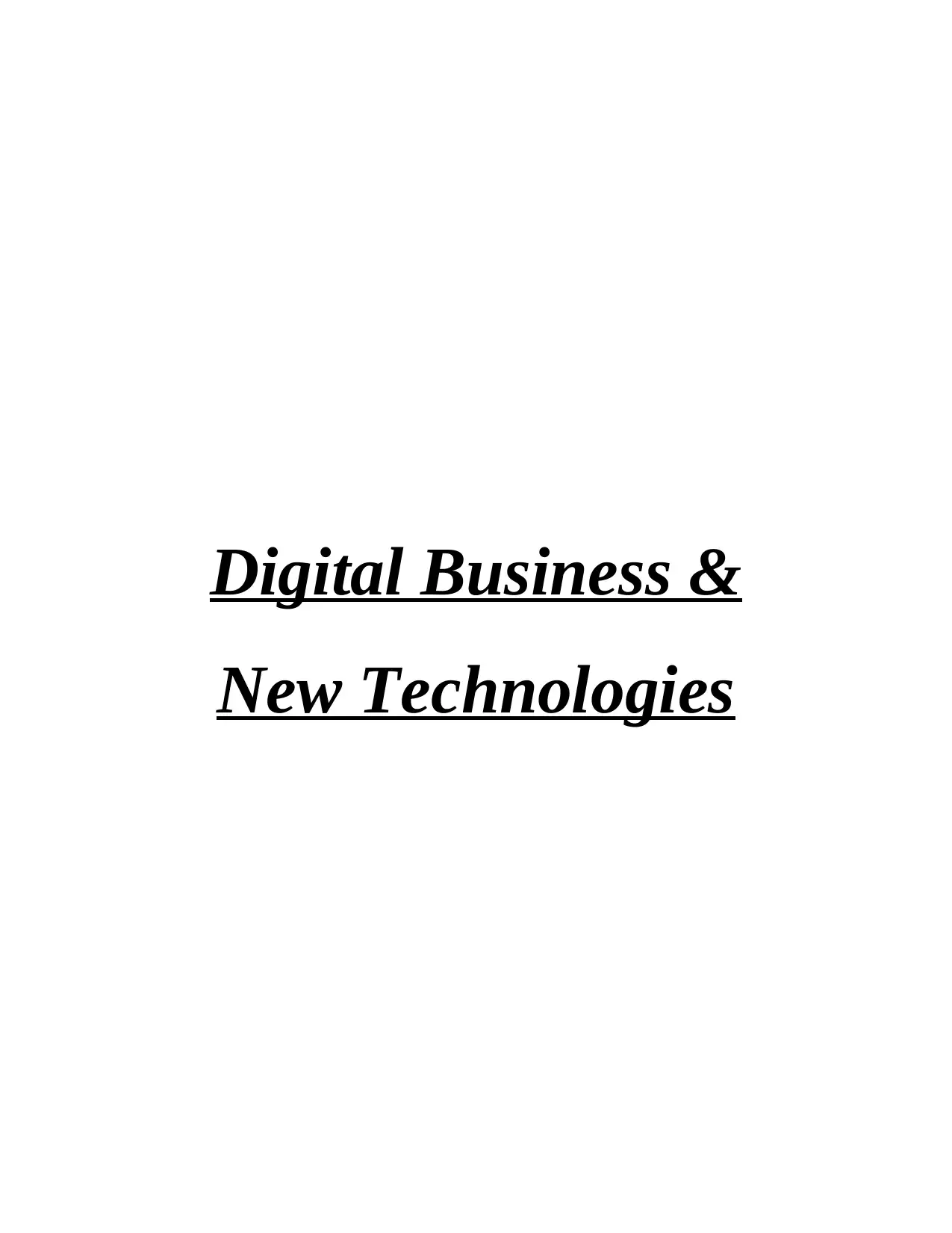
Digital Business &
New Technologies
New Technologies
Paraphrase This Document
Need a fresh take? Get an instant paraphrase of this document with our AI Paraphraser
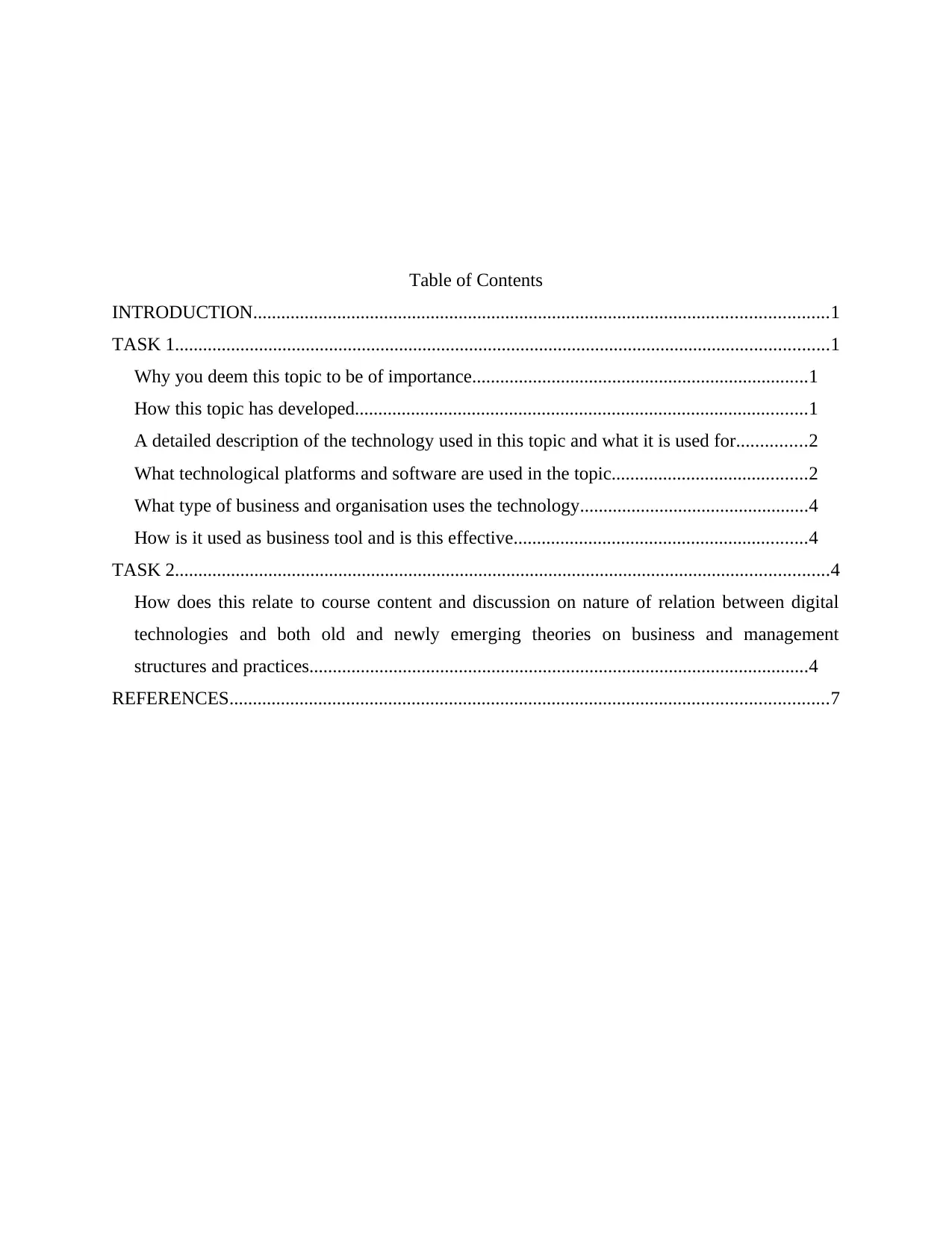
Table of Contents
INTRODUCTION...........................................................................................................................1
TASK 1............................................................................................................................................1
Why you deem this topic to be of importance........................................................................1
How this topic has developed.................................................................................................1
A detailed description of the technology used in this topic and what it is used for...............2
What technological platforms and software are used in the topic..........................................2
What type of business and organisation uses the technology.................................................4
How is it used as business tool and is this effective...............................................................4
TASK 2............................................................................................................................................4
How does this relate to course content and discussion on nature of relation between digital
technologies and both old and newly emerging theories on business and management
structures and practices...........................................................................................................4
REFERENCES................................................................................................................................7
INTRODUCTION...........................................................................................................................1
TASK 1............................................................................................................................................1
Why you deem this topic to be of importance........................................................................1
How this topic has developed.................................................................................................1
A detailed description of the technology used in this topic and what it is used for...............2
What technological platforms and software are used in the topic..........................................2
What type of business and organisation uses the technology.................................................4
How is it used as business tool and is this effective...............................................................4
TASK 2............................................................................................................................................4
How does this relate to course content and discussion on nature of relation between digital
technologies and both old and newly emerging theories on business and management
structures and practices...........................................................................................................4
REFERENCES................................................................................................................................7
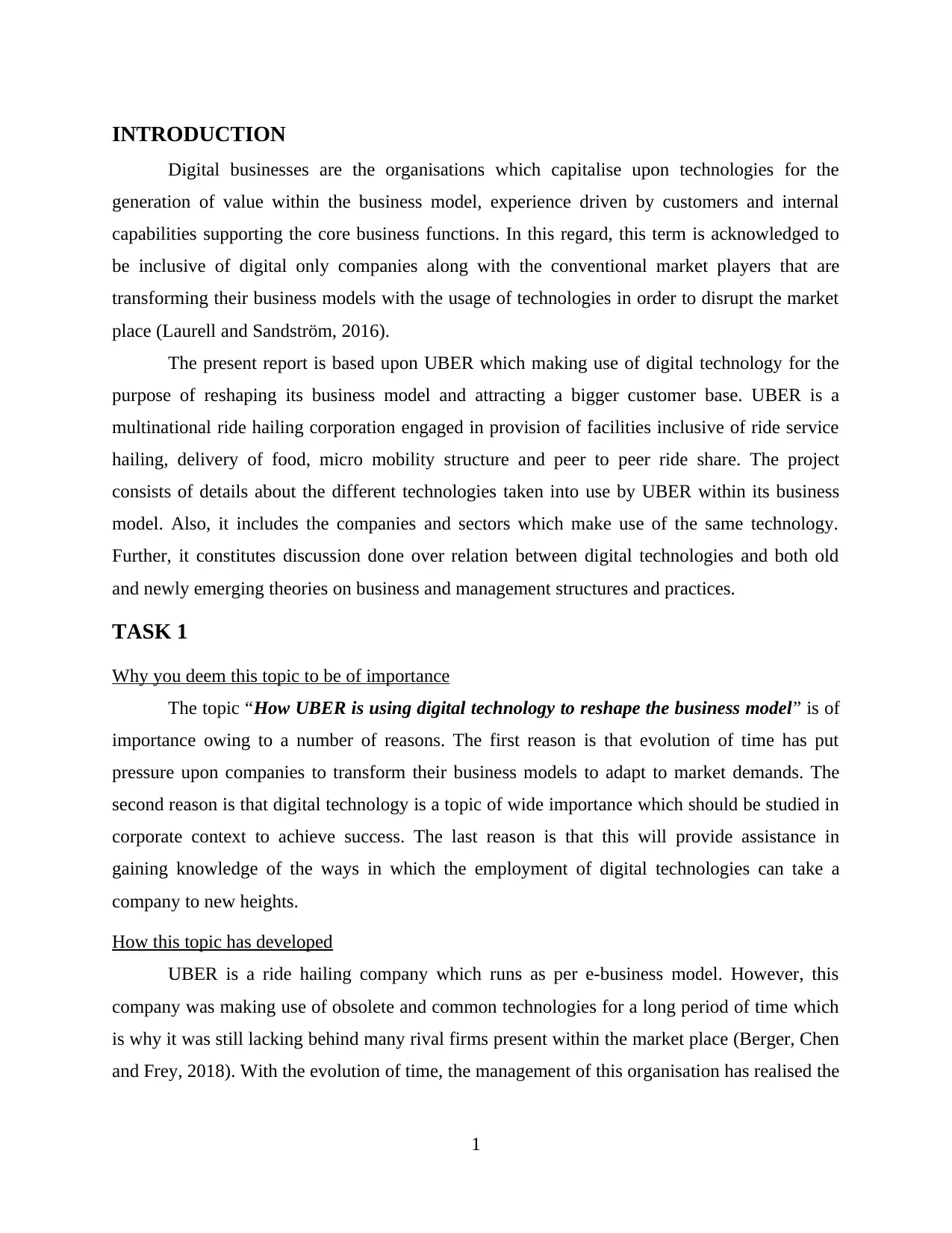
INTRODUCTION
Digital businesses are the organisations which capitalise upon technologies for the
generation of value within the business model, experience driven by customers and internal
capabilities supporting the core business functions. In this regard, this term is acknowledged to
be inclusive of digital only companies along with the conventional market players that are
transforming their business models with the usage of technologies in order to disrupt the market
place (Laurell and Sandström, 2016).
The present report is based upon UBER which making use of digital technology for the
purpose of reshaping its business model and attracting a bigger customer base. UBER is a
multinational ride hailing corporation engaged in provision of facilities inclusive of ride service
hailing, delivery of food, micro mobility structure and peer to peer ride share. The project
consists of details about the different technologies taken into use by UBER within its business
model. Also, it includes the companies and sectors which make use of the same technology.
Further, it constitutes discussion done over relation between digital technologies and both old
and newly emerging theories on business and management structures and practices.
TASK 1
Why you deem this topic to be of importance
The topic “How UBER is using digital technology to reshape the business model” is of
importance owing to a number of reasons. The first reason is that evolution of time has put
pressure upon companies to transform their business models to adapt to market demands. The
second reason is that digital technology is a topic of wide importance which should be studied in
corporate context to achieve success. The last reason is that this will provide assistance in
gaining knowledge of the ways in which the employment of digital technologies can take a
company to new heights.
How this topic has developed
UBER is a ride hailing company which runs as per e-business model. However, this
company was making use of obsolete and common technologies for a long period of time which
is why it was still lacking behind many rival firms present within the market place (Berger, Chen
and Frey, 2018). With the evolution of time, the management of this organisation has realised the
1
Digital businesses are the organisations which capitalise upon technologies for the
generation of value within the business model, experience driven by customers and internal
capabilities supporting the core business functions. In this regard, this term is acknowledged to
be inclusive of digital only companies along with the conventional market players that are
transforming their business models with the usage of technologies in order to disrupt the market
place (Laurell and Sandström, 2016).
The present report is based upon UBER which making use of digital technology for the
purpose of reshaping its business model and attracting a bigger customer base. UBER is a
multinational ride hailing corporation engaged in provision of facilities inclusive of ride service
hailing, delivery of food, micro mobility structure and peer to peer ride share. The project
consists of details about the different technologies taken into use by UBER within its business
model. Also, it includes the companies and sectors which make use of the same technology.
Further, it constitutes discussion done over relation between digital technologies and both old
and newly emerging theories on business and management structures and practices.
TASK 1
Why you deem this topic to be of importance
The topic “How UBER is using digital technology to reshape the business model” is of
importance owing to a number of reasons. The first reason is that evolution of time has put
pressure upon companies to transform their business models to adapt to market demands. The
second reason is that digital technology is a topic of wide importance which should be studied in
corporate context to achieve success. The last reason is that this will provide assistance in
gaining knowledge of the ways in which the employment of digital technologies can take a
company to new heights.
How this topic has developed
UBER is a ride hailing company which runs as per e-business model. However, this
company was making use of obsolete and common technologies for a long period of time which
is why it was still lacking behind many rival firms present within the market place (Berger, Chen
and Frey, 2018). With the evolution of time, the management of this organisation has realised the
1
⊘ This is a preview!⊘
Do you want full access?
Subscribe today to unlock all pages.

Trusted by 1+ million students worldwide
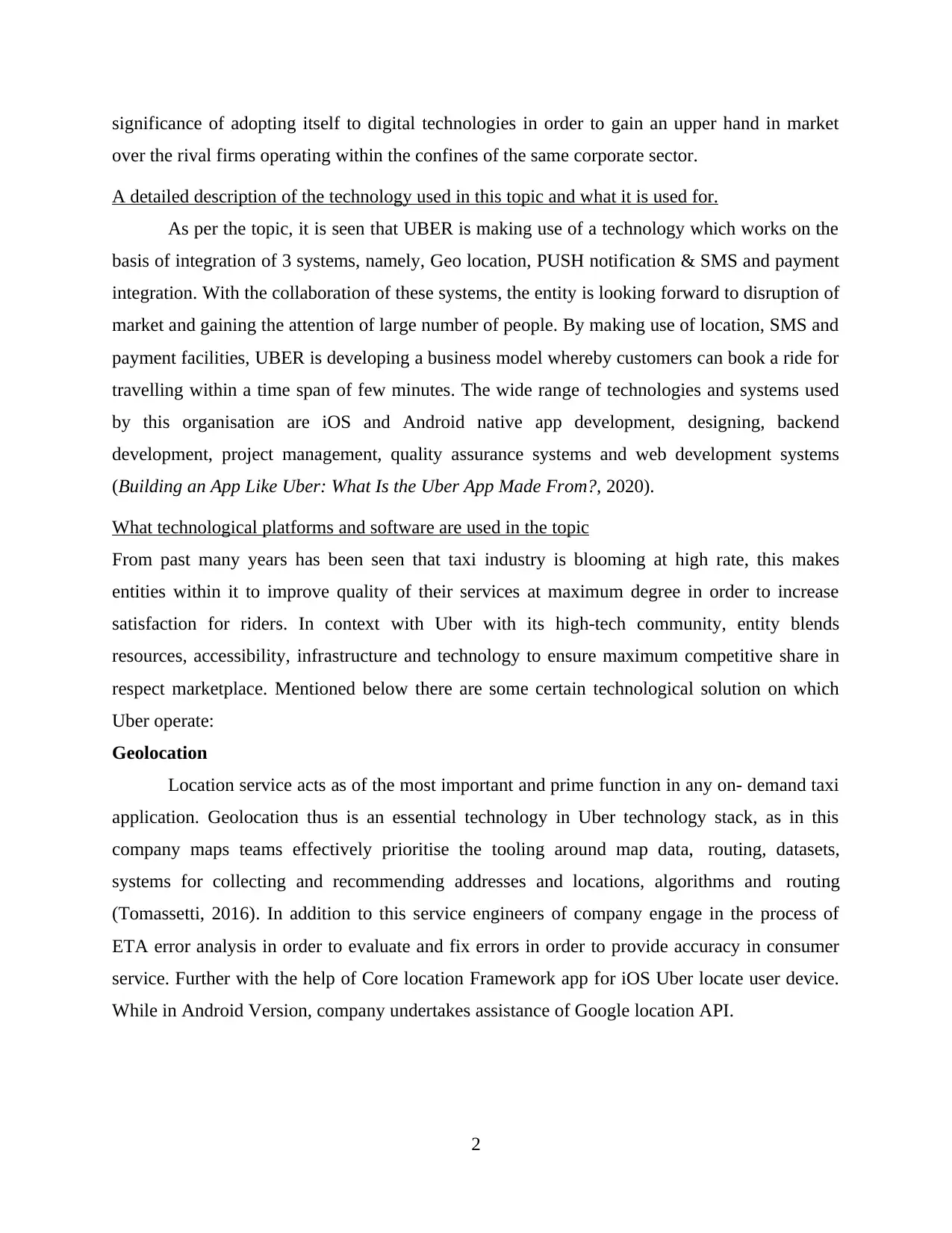
significance of adopting itself to digital technologies in order to gain an upper hand in market
over the rival firms operating within the confines of the same corporate sector.
A detailed description of the technology used in this topic and what it is used for.
As per the topic, it is seen that UBER is making use of a technology which works on the
basis of integration of 3 systems, namely, Geo location, PUSH notification & SMS and payment
integration. With the collaboration of these systems, the entity is looking forward to disruption of
market and gaining the attention of large number of people. By making use of location, SMS and
payment facilities, UBER is developing a business model whereby customers can book a ride for
travelling within a time span of few minutes. The wide range of technologies and systems used
by this organisation are iOS and Android native app development, designing, backend
development, project management, quality assurance systems and web development systems
(Building an App Like Uber: What Is the Uber App Made From?, 2020).
What technological platforms and software are used in the topic
From past many years has been seen that taxi industry is blooming at high rate, this makes
entities within it to improve quality of their services at maximum degree in order to increase
satisfaction for riders. In context with Uber with its high-tech community, entity blends
resources, accessibility, infrastructure and technology to ensure maximum competitive share in
respect marketplace. Mentioned below there are some certain technological solution on which
Uber operate:
Geolocation
Location service acts as of the most important and prime function in any on- demand taxi
application. Geolocation thus is an essential technology in Uber technology stack, as in this
company maps teams effectively prioritise the tooling around map data, routing, datasets,
systems for collecting and recommending addresses and locations, algorithms and routing
(Tomassetti, 2016). In addition to this service engineers of company engage in the process of
ETA error analysis in order to evaluate and fix errors in order to provide accuracy in consumer
service. Further with the help of Core location Framework app for iOS Uber locate user device.
While in Android Version, company undertakes assistance of Google location API.
2
over the rival firms operating within the confines of the same corporate sector.
A detailed description of the technology used in this topic and what it is used for.
As per the topic, it is seen that UBER is making use of a technology which works on the
basis of integration of 3 systems, namely, Geo location, PUSH notification & SMS and payment
integration. With the collaboration of these systems, the entity is looking forward to disruption of
market and gaining the attention of large number of people. By making use of location, SMS and
payment facilities, UBER is developing a business model whereby customers can book a ride for
travelling within a time span of few minutes. The wide range of technologies and systems used
by this organisation are iOS and Android native app development, designing, backend
development, project management, quality assurance systems and web development systems
(Building an App Like Uber: What Is the Uber App Made From?, 2020).
What technological platforms and software are used in the topic
From past many years has been seen that taxi industry is blooming at high rate, this makes
entities within it to improve quality of their services at maximum degree in order to increase
satisfaction for riders. In context with Uber with its high-tech community, entity blends
resources, accessibility, infrastructure and technology to ensure maximum competitive share in
respect marketplace. Mentioned below there are some certain technological solution on which
Uber operate:
Geolocation
Location service acts as of the most important and prime function in any on- demand taxi
application. Geolocation thus is an essential technology in Uber technology stack, as in this
company maps teams effectively prioritise the tooling around map data, routing, datasets,
systems for collecting and recommending addresses and locations, algorithms and routing
(Tomassetti, 2016). In addition to this service engineers of company engage in the process of
ETA error analysis in order to evaluate and fix errors in order to provide accuracy in consumer
service. Further with the help of Core location Framework app for iOS Uber locate user device.
While in Android Version, company undertakes assistance of Google location API.
2
Paraphrase This Document
Need a fresh take? Get an instant paraphrase of this document with our AI Paraphraser
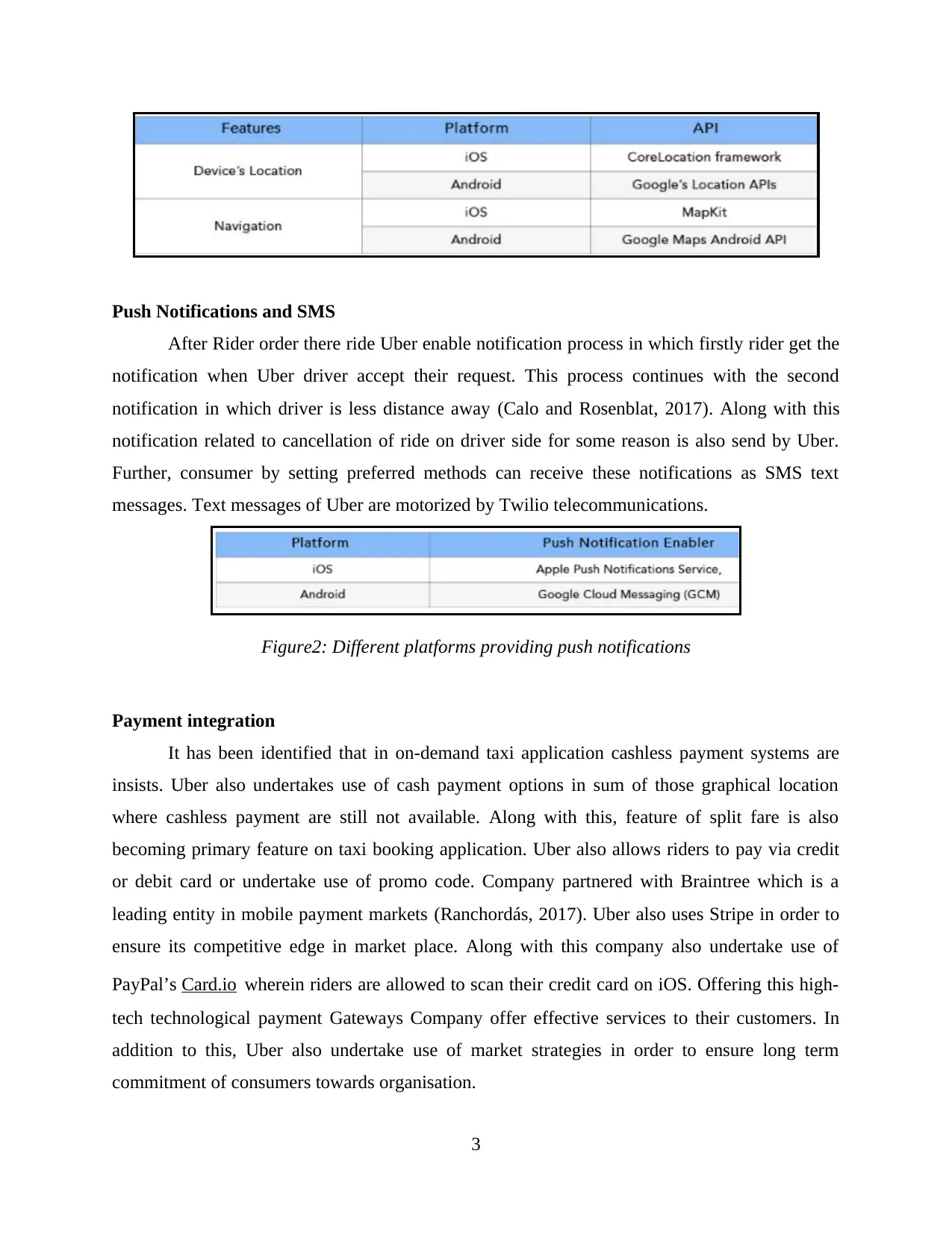
Push Notifications and SMS
After Rider order there ride Uber enable notification process in which firstly rider get the
notification when Uber driver accept their request. This process continues with the second
notification in which driver is less distance away (Calo and Rosenblat, 2017). Along with this
notification related to cancellation of ride on driver side for some reason is also send by Uber.
Further, consumer by setting preferred methods can receive these notifications as SMS text
messages. Text messages of Uber are motorized by Twilio telecommunications.
Figure2: Different platforms providing push notifications
Payment integration
It has been identified that in on-demand taxi application cashless payment systems are
insists. Uber also undertakes use of cash payment options in sum of those graphical location
where cashless payment are still not available. Along with this, feature of split fare is also
becoming primary feature on taxi booking application. Uber also allows riders to pay via credit
or debit card or undertake use of promo code. Company partnered with Braintree which is a
leading entity in mobile payment markets (Ranchordás, 2017). Uber also uses Stripe in order to
ensure its competitive edge in market place. Along with this company also undertake use of
PayPal’s Card.io wherein riders are allowed to scan their credit card on iOS. Offering this high-
tech technological payment Gateways Company offer effective services to their customers. In
addition to this, Uber also undertake use of market strategies in order to ensure long term
commitment of consumers towards organisation.
3
After Rider order there ride Uber enable notification process in which firstly rider get the
notification when Uber driver accept their request. This process continues with the second
notification in which driver is less distance away (Calo and Rosenblat, 2017). Along with this
notification related to cancellation of ride on driver side for some reason is also send by Uber.
Further, consumer by setting preferred methods can receive these notifications as SMS text
messages. Text messages of Uber are motorized by Twilio telecommunications.
Figure2: Different platforms providing push notifications
Payment integration
It has been identified that in on-demand taxi application cashless payment systems are
insists. Uber also undertakes use of cash payment options in sum of those graphical location
where cashless payment are still not available. Along with this, feature of split fare is also
becoming primary feature on taxi booking application. Uber also allows riders to pay via credit
or debit card or undertake use of promo code. Company partnered with Braintree which is a
leading entity in mobile payment markets (Ranchordás, 2017). Uber also uses Stripe in order to
ensure its competitive edge in market place. Along with this company also undertake use of
PayPal’s Card.io wherein riders are allowed to scan their credit card on iOS. Offering this high-
tech technological payment Gateways Company offer effective services to their customers. In
addition to this, Uber also undertake use of market strategies in order to ensure long term
commitment of consumers towards organisation.
3
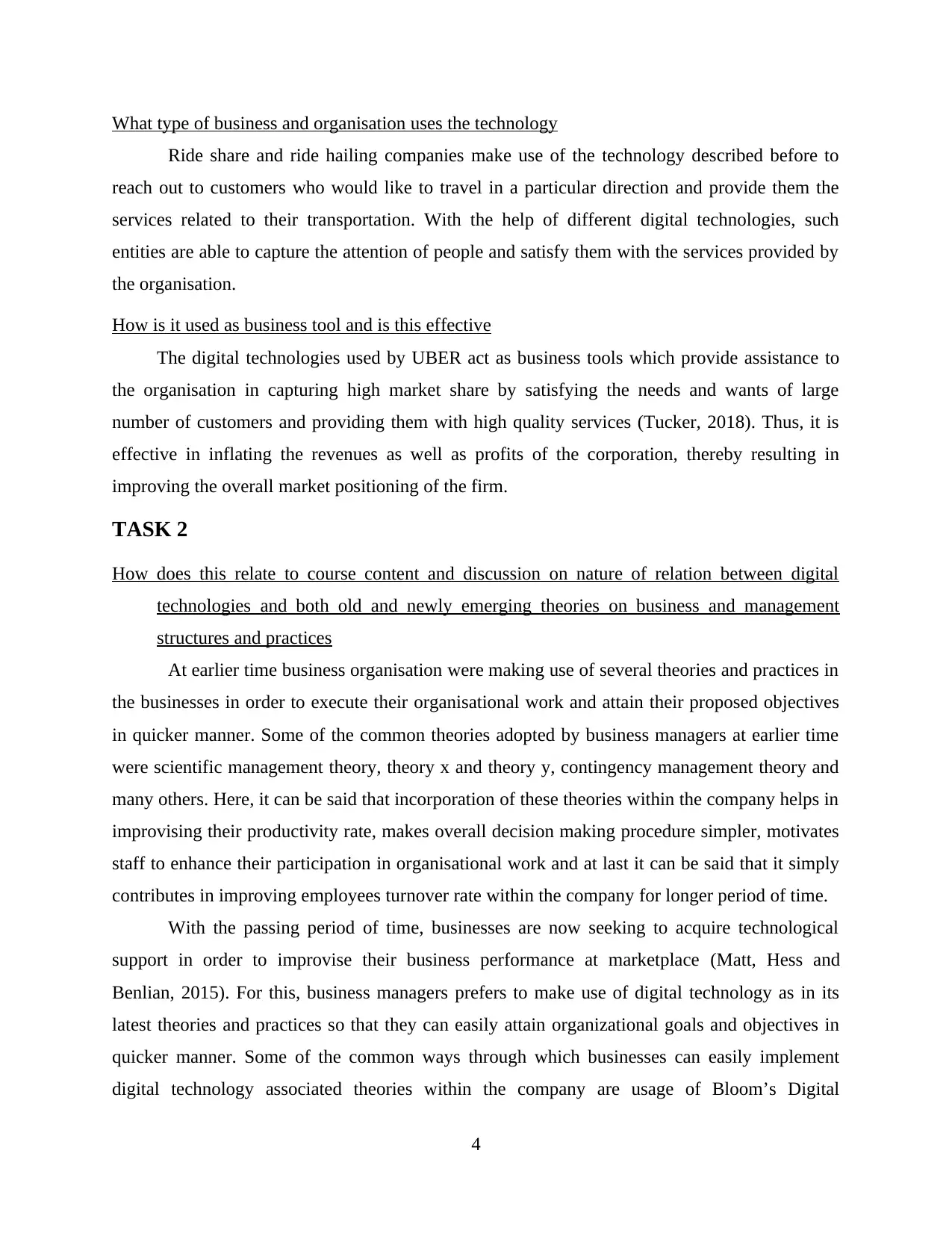
What type of business and organisation uses the technology
Ride share and ride hailing companies make use of the technology described before to
reach out to customers who would like to travel in a particular direction and provide them the
services related to their transportation. With the help of different digital technologies, such
entities are able to capture the attention of people and satisfy them with the services provided by
the organisation.
How is it used as business tool and is this effective
The digital technologies used by UBER act as business tools which provide assistance to
the organisation in capturing high market share by satisfying the needs and wants of large
number of customers and providing them with high quality services (Tucker, 2018). Thus, it is
effective in inflating the revenues as well as profits of the corporation, thereby resulting in
improving the overall market positioning of the firm.
TASK 2
How does this relate to course content and discussion on nature of relation between digital
technologies and both old and newly emerging theories on business and management
structures and practices
At earlier time business organisation were making use of several theories and practices in
the businesses in order to execute their organisational work and attain their proposed objectives
in quicker manner. Some of the common theories adopted by business managers at earlier time
were scientific management theory, theory x and theory y, contingency management theory and
many others. Here, it can be said that incorporation of these theories within the company helps in
improvising their productivity rate, makes overall decision making procedure simpler, motivates
staff to enhance their participation in organisational work and at last it can be said that it simply
contributes in improving employees turnover rate within the company for longer period of time.
With the passing period of time, businesses are now seeking to acquire technological
support in order to improvise their business performance at marketplace (Matt, Hess and
Benlian, 2015). For this, business managers prefers to make use of digital technology as in its
latest theories and practices so that they can easily attain organizational goals and objectives in
quicker manner. Some of the common ways through which businesses can easily implement
digital technology associated theories within the company are usage of Bloom’s Digital
4
Ride share and ride hailing companies make use of the technology described before to
reach out to customers who would like to travel in a particular direction and provide them the
services related to their transportation. With the help of different digital technologies, such
entities are able to capture the attention of people and satisfy them with the services provided by
the organisation.
How is it used as business tool and is this effective
The digital technologies used by UBER act as business tools which provide assistance to
the organisation in capturing high market share by satisfying the needs and wants of large
number of customers and providing them with high quality services (Tucker, 2018). Thus, it is
effective in inflating the revenues as well as profits of the corporation, thereby resulting in
improving the overall market positioning of the firm.
TASK 2
How does this relate to course content and discussion on nature of relation between digital
technologies and both old and newly emerging theories on business and management
structures and practices
At earlier time business organisation were making use of several theories and practices in
the businesses in order to execute their organisational work and attain their proposed objectives
in quicker manner. Some of the common theories adopted by business managers at earlier time
were scientific management theory, theory x and theory y, contingency management theory and
many others. Here, it can be said that incorporation of these theories within the company helps in
improvising their productivity rate, makes overall decision making procedure simpler, motivates
staff to enhance their participation in organisational work and at last it can be said that it simply
contributes in improving employees turnover rate within the company for longer period of time.
With the passing period of time, businesses are now seeking to acquire technological
support in order to improvise their business performance at marketplace (Matt, Hess and
Benlian, 2015). For this, business managers prefers to make use of digital technology as in its
latest theories and practices so that they can easily attain organizational goals and objectives in
quicker manner. Some of the common ways through which businesses can easily implement
digital technology associated theories within the company are usage of Bloom’s Digital
4
⊘ This is a preview!⊘
Do you want full access?
Subscribe today to unlock all pages.

Trusted by 1+ million students worldwide
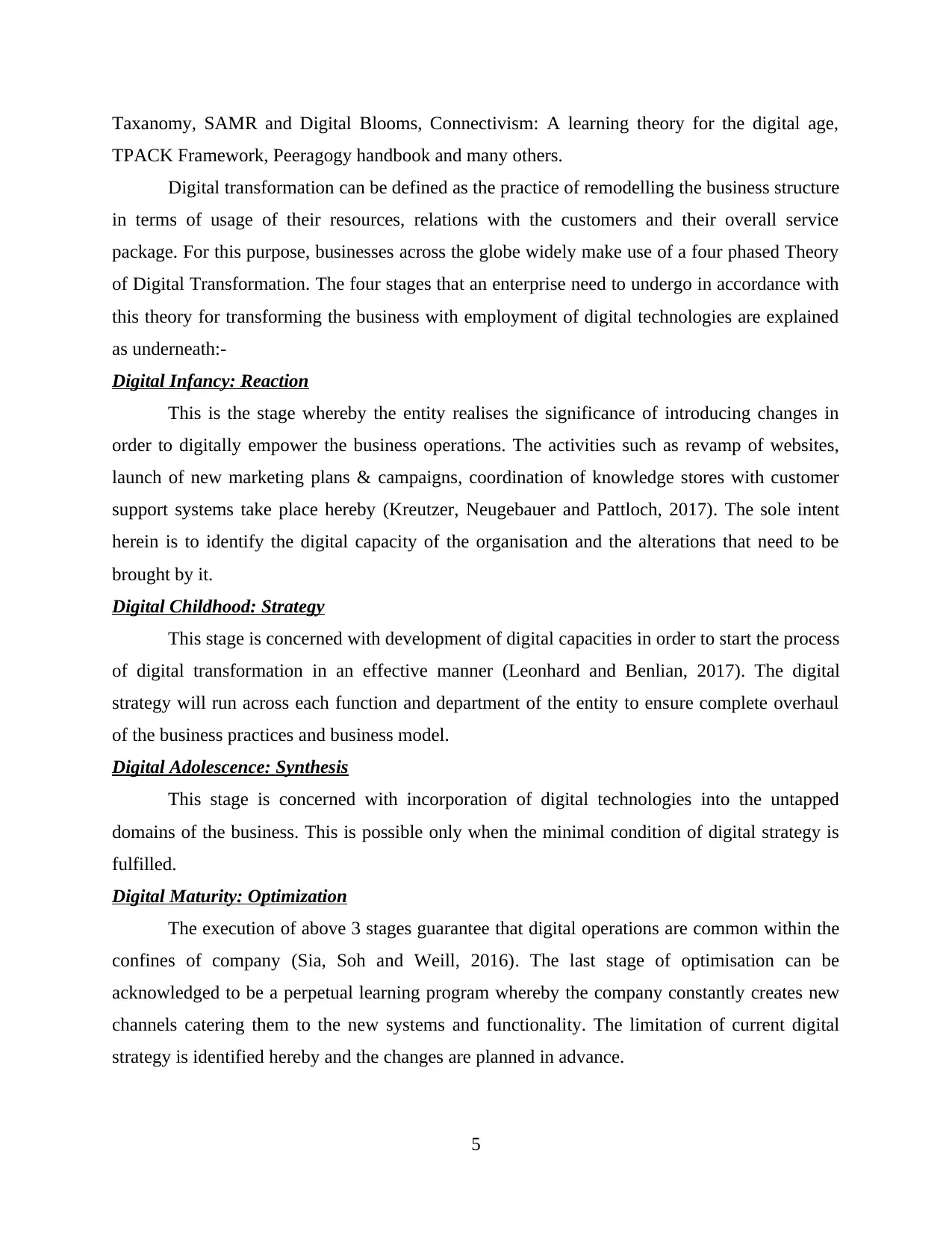
Taxanomy, SAMR and Digital Blooms, Connectivism: A learning theory for the digital age,
TPACK Framework, Peeragogy handbook and many others.
Digital transformation can be defined as the practice of remodelling the business structure
in terms of usage of their resources, relations with the customers and their overall service
package. For this purpose, businesses across the globe widely make use of a four phased Theory
of Digital Transformation. The four stages that an enterprise need to undergo in accordance with
this theory for transforming the business with employment of digital technologies are explained
as underneath:-
Digital Infancy: Reaction
This is the stage whereby the entity realises the significance of introducing changes in
order to digitally empower the business operations. The activities such as revamp of websites,
launch of new marketing plans & campaigns, coordination of knowledge stores with customer
support systems take place hereby (Kreutzer, Neugebauer and Pattloch, 2017). The sole intent
herein is to identify the digital capacity of the organisation and the alterations that need to be
brought by it.
Digital Childhood: Strategy
This stage is concerned with development of digital capacities in order to start the process
of digital transformation in an effective manner (Leonhard and Benlian, 2017). The digital
strategy will run across each function and department of the entity to ensure complete overhaul
of the business practices and business model.
Digital Adolescence: Synthesis
This stage is concerned with incorporation of digital technologies into the untapped
domains of the business. This is possible only when the minimal condition of digital strategy is
fulfilled.
Digital Maturity: Optimization
The execution of above 3 stages guarantee that digital operations are common within the
confines of company (Sia, Soh and Weill, 2016). The last stage of optimisation can be
acknowledged to be a perpetual learning program whereby the company constantly creates new
channels catering them to the new systems and functionality. The limitation of current digital
strategy is identified hereby and the changes are planned in advance.
5
TPACK Framework, Peeragogy handbook and many others.
Digital transformation can be defined as the practice of remodelling the business structure
in terms of usage of their resources, relations with the customers and their overall service
package. For this purpose, businesses across the globe widely make use of a four phased Theory
of Digital Transformation. The four stages that an enterprise need to undergo in accordance with
this theory for transforming the business with employment of digital technologies are explained
as underneath:-
Digital Infancy: Reaction
This is the stage whereby the entity realises the significance of introducing changes in
order to digitally empower the business operations. The activities such as revamp of websites,
launch of new marketing plans & campaigns, coordination of knowledge stores with customer
support systems take place hereby (Kreutzer, Neugebauer and Pattloch, 2017). The sole intent
herein is to identify the digital capacity of the organisation and the alterations that need to be
brought by it.
Digital Childhood: Strategy
This stage is concerned with development of digital capacities in order to start the process
of digital transformation in an effective manner (Leonhard and Benlian, 2017). The digital
strategy will run across each function and department of the entity to ensure complete overhaul
of the business practices and business model.
Digital Adolescence: Synthesis
This stage is concerned with incorporation of digital technologies into the untapped
domains of the business. This is possible only when the minimal condition of digital strategy is
fulfilled.
Digital Maturity: Optimization
The execution of above 3 stages guarantee that digital operations are common within the
confines of company (Sia, Soh and Weill, 2016). The last stage of optimisation can be
acknowledged to be a perpetual learning program whereby the company constantly creates new
channels catering them to the new systems and functionality. The limitation of current digital
strategy is identified hereby and the changes are planned in advance.
5
Paraphrase This Document
Need a fresh take? Get an instant paraphrase of this document with our AI Paraphraser
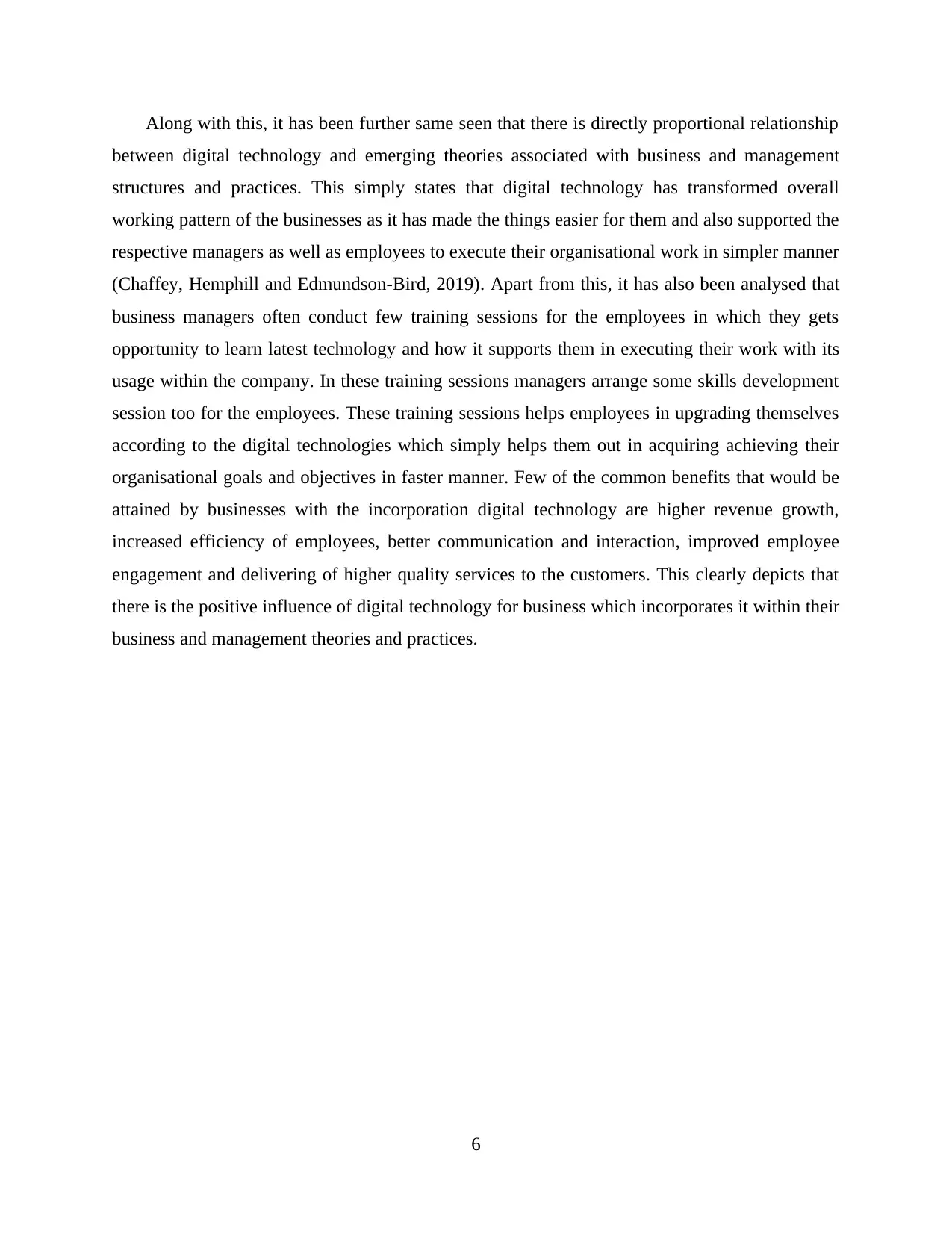
Along with this, it has been further same seen that there is directly proportional relationship
between digital technology and emerging theories associated with business and management
structures and practices. This simply states that digital technology has transformed overall
working pattern of the businesses as it has made the things easier for them and also supported the
respective managers as well as employees to execute their organisational work in simpler manner
(Chaffey, Hemphill and Edmundson-Bird, 2019). Apart from this, it has also been analysed that
business managers often conduct few training sessions for the employees in which they gets
opportunity to learn latest technology and how it supports them in executing their work with its
usage within the company. In these training sessions managers arrange some skills development
session too for the employees. These training sessions helps employees in upgrading themselves
according to the digital technologies which simply helps them out in acquiring achieving their
organisational goals and objectives in faster manner. Few of the common benefits that would be
attained by businesses with the incorporation digital technology are higher revenue growth,
increased efficiency of employees, better communication and interaction, improved employee
engagement and delivering of higher quality services to the customers. This clearly depicts that
there is the positive influence of digital technology for business which incorporates it within their
business and management theories and practices.
6
between digital technology and emerging theories associated with business and management
structures and practices. This simply states that digital technology has transformed overall
working pattern of the businesses as it has made the things easier for them and also supported the
respective managers as well as employees to execute their organisational work in simpler manner
(Chaffey, Hemphill and Edmundson-Bird, 2019). Apart from this, it has also been analysed that
business managers often conduct few training sessions for the employees in which they gets
opportunity to learn latest technology and how it supports them in executing their work with its
usage within the company. In these training sessions managers arrange some skills development
session too for the employees. These training sessions helps employees in upgrading themselves
according to the digital technologies which simply helps them out in acquiring achieving their
organisational goals and objectives in faster manner. Few of the common benefits that would be
attained by businesses with the incorporation digital technology are higher revenue growth,
increased efficiency of employees, better communication and interaction, improved employee
engagement and delivering of higher quality services to the customers. This clearly depicts that
there is the positive influence of digital technology for business which incorporates it within their
business and management theories and practices.
6
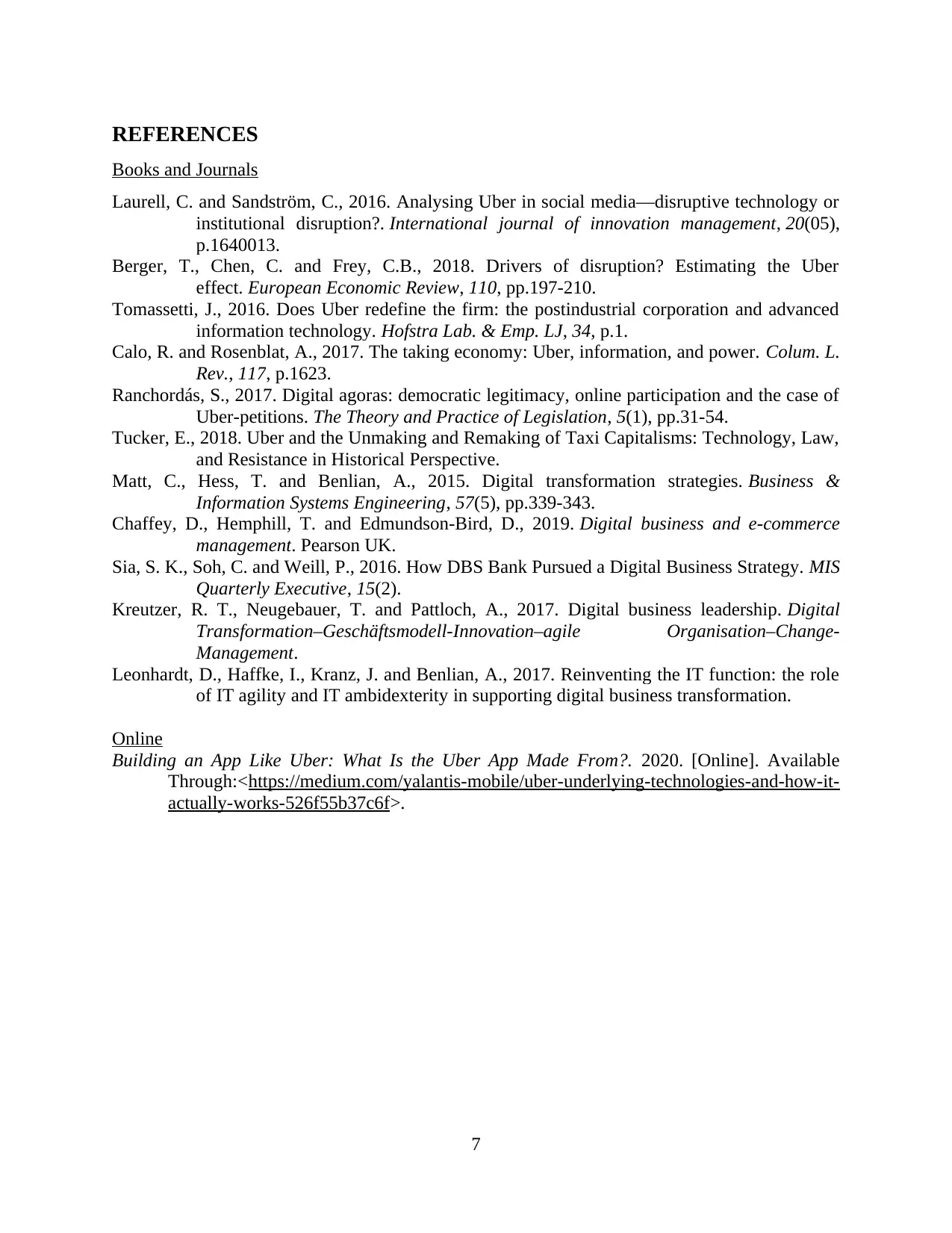
REFERENCES
Books and Journals
Laurell, C. and Sandström, C., 2016. Analysing Uber in social media—disruptive technology or
institutional disruption?. International journal of innovation management, 20(05),
p.1640013.
Berger, T., Chen, C. and Frey, C.B., 2018. Drivers of disruption? Estimating the Uber
effect. European Economic Review, 110, pp.197-210.
Tomassetti, J., 2016. Does Uber redefine the firm: the postindustrial corporation and advanced
information technology. Hofstra Lab. & Emp. LJ, 34, p.1.
Calo, R. and Rosenblat, A., 2017. The taking economy: Uber, information, and power. Colum. L.
Rev., 117, p.1623.
Ranchordás, S., 2017. Digital agoras: democratic legitimacy, online participation and the case of
Uber-petitions. The Theory and Practice of Legislation, 5(1), pp.31-54.
Tucker, E., 2018. Uber and the Unmaking and Remaking of Taxi Capitalisms: Technology, Law,
and Resistance in Historical Perspective.
Matt, C., Hess, T. and Benlian, A., 2015. Digital transformation strategies. Business &
Information Systems Engineering, 57(5), pp.339-343.
Chaffey, D., Hemphill, T. and Edmundson-Bird, D., 2019. Digital business and e-commerce
management. Pearson UK.
Sia, S. K., Soh, C. and Weill, P., 2016. How DBS Bank Pursued a Digital Business Strategy. MIS
Quarterly Executive, 15(2).
Kreutzer, R. T., Neugebauer, T. and Pattloch, A., 2017. Digital business leadership. Digital
Transformation–Geschäftsmodell-Innovation–agile Organisation–Change-
Management.
Leonhardt, D., Haffke, I., Kranz, J. and Benlian, A., 2017. Reinventing the IT function: the role
of IT agility and IT ambidexterity in supporting digital business transformation.
Online
Building an App Like Uber: What Is the Uber App Made From?. 2020. [Online]. Available
Through:<https://medium.com/yalantis-mobile/uber-underlying-technologies-and-how-it-
actually-works-526f55b37c6f>.
7
Books and Journals
Laurell, C. and Sandström, C., 2016. Analysing Uber in social media—disruptive technology or
institutional disruption?. International journal of innovation management, 20(05),
p.1640013.
Berger, T., Chen, C. and Frey, C.B., 2018. Drivers of disruption? Estimating the Uber
effect. European Economic Review, 110, pp.197-210.
Tomassetti, J., 2016. Does Uber redefine the firm: the postindustrial corporation and advanced
information technology. Hofstra Lab. & Emp. LJ, 34, p.1.
Calo, R. and Rosenblat, A., 2017. The taking economy: Uber, information, and power. Colum. L.
Rev., 117, p.1623.
Ranchordás, S., 2017. Digital agoras: democratic legitimacy, online participation and the case of
Uber-petitions. The Theory and Practice of Legislation, 5(1), pp.31-54.
Tucker, E., 2018. Uber and the Unmaking and Remaking of Taxi Capitalisms: Technology, Law,
and Resistance in Historical Perspective.
Matt, C., Hess, T. and Benlian, A., 2015. Digital transformation strategies. Business &
Information Systems Engineering, 57(5), pp.339-343.
Chaffey, D., Hemphill, T. and Edmundson-Bird, D., 2019. Digital business and e-commerce
management. Pearson UK.
Sia, S. K., Soh, C. and Weill, P., 2016. How DBS Bank Pursued a Digital Business Strategy. MIS
Quarterly Executive, 15(2).
Kreutzer, R. T., Neugebauer, T. and Pattloch, A., 2017. Digital business leadership. Digital
Transformation–Geschäftsmodell-Innovation–agile Organisation–Change-
Management.
Leonhardt, D., Haffke, I., Kranz, J. and Benlian, A., 2017. Reinventing the IT function: the role
of IT agility and IT ambidexterity in supporting digital business transformation.
Online
Building an App Like Uber: What Is the Uber App Made From?. 2020. [Online]. Available
Through:<https://medium.com/yalantis-mobile/uber-underlying-technologies-and-how-it-
actually-works-526f55b37c6f>.
7
⊘ This is a preview!⊘
Do you want full access?
Subscribe today to unlock all pages.

Trusted by 1+ million students worldwide
1 out of 9
Related Documents
Your All-in-One AI-Powered Toolkit for Academic Success.
+13062052269
info@desklib.com
Available 24*7 on WhatsApp / Email
![[object Object]](/_next/static/media/star-bottom.7253800d.svg)
Unlock your academic potential
Copyright © 2020–2025 A2Z Services. All Rights Reserved. Developed and managed by ZUCOL.





